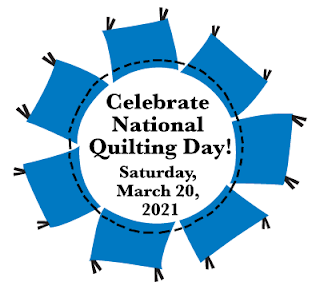Since National Quilting Day is March 20, the focus of this blog post will be on documenting quilts. In spite of that, the suggestions below apply to most heirlooms.
About the Quilt's History:
Three Steps for Documenting
The three basic steps of documenting an heirloom include writing, labeling, and photographing.1. Write about your quilt.
Record what you know about the quilt in writing. You’ll want to both document its history and its current whereabouts. The more you write, the better documented the quilt will be for future generations. At a minimum, try to answer the 5 W (+ 1 H) questions, including:About the Quilt's History:
- Who made it?
- How was it made? Note if it is hand or machine sewn/quilted or uses techniques like applique or embroidery.
- What does it look like? Describe it’s dimensions, condition, fabrics, color scheme, and pattern.
- Where was it made?
- When was it made?
- Why was it made?
- Who owns it?
- Where (at what address) is the quilt at now?
- When did the current owner inherit or purchase it?
 |
| This "Double Wedding Ring" quilt may have been created as a gift for newlyweds. |
- If they’re still living, talk to the quilt’s maker or a previous owner.
- For an heirloom that’s been passed down in your family, ask relatives for help.
- Research the quilt’s pattern.
Where: Some patterns, including the “Ohio Star,” the “Arkansas Traveler,” the “Nebraska Pinwheel,” have geographic connections.
"Anvil" Quilt Pattern
(also called "Jacob's Ladder")- When: Other patterns might suggest a time period for when they were created; for example, the “Lincoln Platform” pattern could only have been made after 1862.
- Why: Patterns may also give you clues about your family’s occupations, interests, and life events. For example, various patterns are called the “Anvil” (blacksmithing), the “Saw-Tooth” (carpentry), the “Corn and Beans” (farming), or the “Compass” (sailing). Blue and white quilts -- especially in the pattern the “Drunkard’s Path” -- may indicate an individual’s participation in the temperance movement. Meanwhile a “Wedding Ring” pattern may have been made as a wedding gift.
Important Note: A pattern may not have a deeper significance -- the quilt’s maker may have simply selected a pattern because they liked it!
Some resources for quilt identification are noted below.
2. Make a label for your quilt.
Using the information you’ve researched, collected, and written down, create a label for your quilt. The golden rule of labeling an heirloom is to never do something that can’t be undone (without damaging the item). For a quilt, you’ll make your label from a natural fiber fabric and an archival, permanent pen. You’ll attach the label by hand sewing it in place with cotton thread. For detailed directions on how to label quilts, see the Quilt Alliance’s “Label It Already!” post at https://quiltalliance.org/labeling/label-it-already.3. Take (several) photographs of your quilt.
- Make sure to get a snapshot of both the front and back.
- On the front, take an image of the overall design, but also detailed views of a block, border, or any unique features.
- On the back, make sure you photograph the label you’ve added.
- If the maker is living, photograph them with the quilt. If the maker is deceased, take a selfie with it to document yourself as the owner! If you use the quilt, photograph it in the context of your home.
 |
| Make sure to take a phot of the full quilt top, plus some detail snapshots. In this photo of a "Drunkard's Path," it documents the two blocks, plus the double border, and binding. |
FAQ
- Want to make your own quilt, but don’t have a sewing machine? You can make an appointment to use the sewing machine in MCDL Makerspace. Just contact us at 330-725-0588 x5017 or makerspace@mcdl.info.
- Trying to identify a quilt pattern, but not making much progress? Email a photo of your quilt to the MCDL Genealogy Team at me-team.genealogy@mcdl.info and we’ll see if we can determine which pattern block was used.
- Need information on preserving quilts or other family heirlooms? Sign up to attend the Genealogy Slam! The live virtual event will be held on Saturday, April 24. The first session will focus on preserving your family’s treasures. Register to attend at https://mcdl.info/slam.
Resources
- For more ideas for celebrating National Quilting Day, see https://quiltalliance.org/nationalquiltingday.
- Learn about “reading” a quilt at https://www.ncmuseumofhistory.org/reading-history-quilts-and-museum-detectives-use-solid-evidence.
- See examples of traditional patterns at https://www.nps.gov/home/planyourvisit/quilt-discovery-experience.htm.
- To research quilt patterns, use your library card to place holds on “5,500 Quilt Block Designs,” “Encyclopedia of Pieced Quilt Patterns,” or “The Collector's Dictionary of Quilt Names & Patterns.” “The Collector’s Dictionary…” can also be borrowed as a digital copy briefly from the Internet Archive at https://archive.org/details/collectorsdictio00khin.
- For more patterns, search 50,000+ images on The Quilt Index at https://quiltindex.org.
- Learn about Ohio History Connection’s “Ohio Quilt Research Project” at https://www.ohiohistory.org/learn/collections/history/history-blog/2017/march-2017/oqrp.
- Download your free Heirloom Documentation Form.






No comments:
Post a Comment